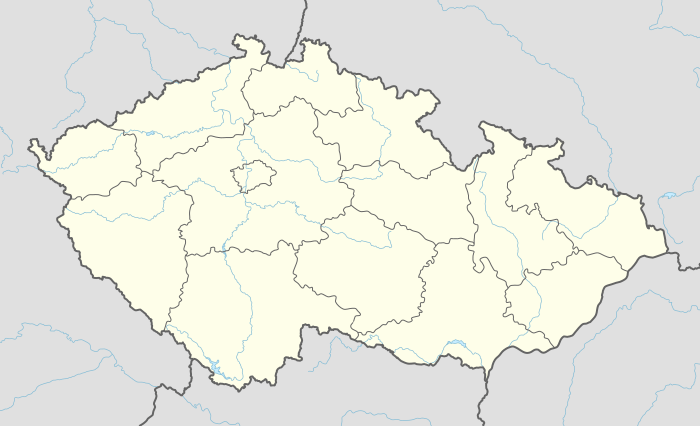Novosedly (Břeclav District)
Novosedly na Moravě (German: Neusiedl) is a village in the South Moravian Region (Jihomoravský kraj), Břeclav District in the Czech Republic.
Novosedly | |
|---|---|
Village | |
%2C_sloup.jpg) Virgin Mary column in Novosedly | |
_vlajka.jpg) Flag .jpeg) Coat of arms | |
 Novosedly Location in the Czech Republic | |
| Coordinates: 48°50′4″N 16°30′15″E | |
| Country | Czech Republic |
| Region | South Moravian |
| District | Břeclav |
| Area | |
| • Total | 16.68 km2 (6.44 sq mi) |
| Elevation | 173 m (568 ft) |
| Population (2012) | |
| • Total | 1,145 |
| • Density | 69/km2 (180/sq mi) |
| Time zone | UTC+1 (CET) |
| • Summer (DST) | UTC+2 (CEST) |
| Postal code | 691 82 |
| Website | www.novosedlynamorave.cz |
Geography
The village lies on the Dyje River. Because of its soil conditions it was called in the past as “Neusiedl am Sand” (Neusiedl in the sand). The mountains of Drnholec with its tops of the “Alte Haide” (260 m) and the “Steinhaide” (273 m), the mountains of Prerau to the south with the “Bergried” (224 m) emboss the township with fruitful vineyards.
History
The creation of the town seems to have taken place in the 11th century and its parish was founded in 1181. In 1230 it was merged to Moravia and early together with church and daughter, to Falkenstein. The Ius patronatus (right of patronage) was held by the Abbey of Kanitz until its dissolution in 1538. Big damage was done by the Hussites in 1426. Because of being part of the possession of Dürnholz, together with it fell to the House of Liechtenstein in 1394. It was parsoned like Dürnholz from 1642 until 1848. 1576 there existed a market, in 1771 an expositur and in 1785 its own parish. In 1785 a relocation of the graveyard away from the church took place. In 1831 the cholera caused 72 victims and in the same year they built a chapel on the way to Prerau with a sculpture of the flagellated Christ in it. In 1871 the railway line "Lundenburg-Grusbach" was built and in 1872 the line "Neusiedl-Laa". In 1883 the "Kellergasse" (cellar lane) was established and in 1887 two thirds of the town were burned up in a fire. At the railway station "Neusiedl-Dürnbach" of the line from Lundenburg to Znaim there was a separate railway line to Laa/Thaya from 1872 until 1919. A farmers market was held every Tuesday from 1872 onward, but was suspended later, running out of need, because of the market in neighboring Dürnholz. Parish registers have existed from 1649 onward and land registration since 1751.
A traditional holiday was the festival of the 4th of July (Saint Ulrich), which was switched to the 16th of August (Saint Rochus) in the 19th century because of the field work during harvest time. The industrial places in the town were the grain mill (built anew in 1899 with a new warehouse and a steam-powered mill), which was financed by the central association of the German agricultural cooperative. The old grain mill by the Thaya - first mentioned in the urbar in 1414 with six set of millstones was sold in 1786 and built anew in 1811. It was closed in 1886/87 because of the drainage of the Thaya river.
After World War I the multi-ethnic state Austria–Hungary was split up. By the Treaty of Saint-Germain-en-Laye Neusiedl became part of the new Czechoslovakian Republic. In 1929 a cheese dairy was founded and in 1930 a brickworks. Following the Munich Agreement German troops marched into the town in October 1938. From that time onward the town belonged to the Reichsgau Niederdonau until 1945. After the end of World War II the town fell back to Czechoslovakia. After 1945/46 the Confiscation of all the German goods by the Czech administrators began. Lots of the inhabitants fled away or were driven across the Austrian-Czechoslovakian border.
A seal of the town has been documented since the 17th century. The seal shows a baroque shield encircled by a crest of flowers. The shield shows a church with two windows, a cross on its roof and a hexagonal lantern on its spire.
Population development
| Census year | Population | Ethnicity of inhabitants | ||
| year | German | Czechs | other | |
| 1793 | 668 | - | - | - |
| 1836 | 599 | - | - | - |
| 1869 | 1183 | - | - | - |
| 1880 | 1288 | 1278 | 9 | 1 |
| 1890 | 1364 | 1358 | 5 | 1 |
| 1900 | 1343 | 1334 | 2 | 7 |
| 1910 | 1348 | 1341 | 3 | 4 |
| 1921 | 1427 | 1309 | 76 | 42 |
| 1930 | 1472 | 1278 | 158 | 36 |
References
- German literature:
- Knee Josef: Neusiedl an der Thaya. 1991
- Alfred Schickel, Gerald Frodl: Geschichte Südmährens, Bd.3, 2001, Neusiedl: Seite.250, 252, 406, 409, 422, 423, 431, 491, 514, 573
- Gerald Frodl, Walfried Blaschka: Kreis Nikolsburg von A–Z, 2006, Neusiedl: Seite 138
- Bruno Kaukal: Wappen und Siegel 1992, Neusiedl S. 163
Notes
- Historický místopis Moravy a Slezska v letech 1848–1960, sv.9. 1984
| Wikimedia Commons has media related to Novosedly (Břeclav District). |